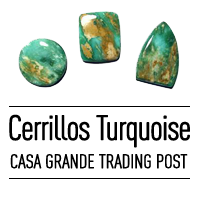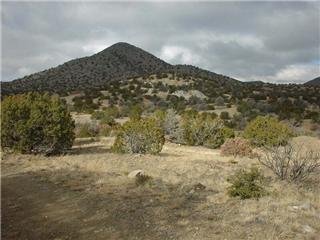Mining History
Cerrillos Hills Mining District - New Mexico
Mount Chalchihuitl is the site of the largest known prehistoric mining operation and the largest single deposit of turquoise ever found in North America. Native American cultures extensively worked the slopes of Mount Chalchihuitl and Turquoise Hill as early as A.D. 900. From the surface pits and short tunnels and shallow shafts, they recovered large quantities of beautifully colored turquoise stone. Because the prehistoric miners were limited to the use of stone tools, the extent of their mining is remarkable. As a trading commodity, the turquoise from Mount Chalchihuitl found its way throughout the southwest and to Canada and Mexico.
After 1300 A.D., members of the nearby San Marcos Pueblo mined and controlled the turquoise deposits. According to legend, Spanish explorer Francisco Coronado sent specimens of Cerrillos turquoise to Spain in 1541 to join the crown jewel collection. And according to other undocumented legends, the Spanish later exploited the mines supposedly using Indian slave labor. These events triggered the Pueblo Revolt of 1680.
Pueblo Indians continued to mine the Mount Chalchihuitl and Turquoise Hill deposits until the early 1870’s, when a silver strike attracted an influx of miners who opened a new chapter in the Cerrillos turquoise story.
Most miners worked the district’s silver-lead-zinc-gold ores, but others were drawn to the old Indian turquoise mines. Modern mining operations began at Turquoise Hill in 1875 and at Mount Chalchihuitl a decade later.
The turquoise occurred as nodules, seams and veins. During the 1880’s, veins as thick as 3 inches were not uncommon. Cerrillos turquoise colors vary considerably; from pure sky blue to blue greens and greens with little blue at all. Specimens are often stained or streaked with limonite and bright specks of pyrite are sometimes present.
With several well-financed mining projects, turquoise mining peaked in the 1890’s. Miners eventually recovered more than $2,000,000 in fine turquoise; shipping most of it East for cutting and polishing. Until 1910, when the richest turquoise veins were exhausted, the Cerrillos district was the world’s largest source of fine turquoise.
After the demise of turquoise mining, the district continued intermittently to produce silver, lead, zinc and small amounts of gold. When district mining halted in the early 1950’s cumulative metal production amounted to a half-million dollars.
Many small mines are scattered throughout the district. Dump minerals include argentiferous galena, sphalerite, chalcopyrite, quartz and small amounts of azurite, Chrysocolla, malachite and wulfenite crystals. The mines are privately owned.
:: A Brief History of the Cerrillos Mining District ::
When measured by dollar value of mineral production, New Mexico’s Cerrillos Mining District is just another name on the long list of districts that never met their expectations. But when considered in collective terms of long activity, history and cultural and geological significance, Cerrillos stands head and shoulders above every other mining district in the American West.
While Cerrillos produced some silver, lead and zinc, it is best known for its turquoise, which many experts believe ranks with the most beautiful ever mined. But Cerrillos has many other distinctions. It is the oldest continuously mined site on the continent, with systematic mining going back more than a thousand years. Cerrillos is also the oldest historically documented mining district in the United States, having first been formally organized during Spanish colonial times in the early 1600’s. Over the centuries, Cerrillos has produced more turquoise than any other site in the Southwest and events that transpired at Cerrillos in the 1880’s led directly to the recognition of turquoise as a valuable and desirable gemstone.
Cerrillos is just a short drive south of Santa Fe in northern New Mexico. The literal translation of its name “little hills” accurately reflects the district’s appearance from a distance – as a group of low hills roughly midway between Santa Fe and the more prominent Ortiz Mountains farther south.
Initially, Native American miners at Cerrillos simply gathered loose turquoise from the surface or chipped it from outcrops. When that surface material was exhausted, they turned to digging open pits. Later they followed rich veins underground, driving narrow, twisting drifts using only crude stone hammers and the heat of fires to crack the solid rock.
The Puebloans mined both turquoise and lead at Cerrillos, using lead oxides and carbonates recovered from the oxidized outcrops to make lead-based glazes used to decorate traditional Rio Grande Pueblo pottery, Galisteo basin glaze ware.
The extent of prehistoric mining at Mount Chalchihuitl is remarkable. Over seven centuries, Native American miners quarried out the entire north side of the hill, removing many thousands of tons of rock over a 20-acre area. The main portion of the central pit, which was carved from solid rock, measures 130 feet deep and more than 200 feet across.
A new era in Cerrillos mining began in the early 1600’s when newly arrived Spanish settlers started mining silver and lead at the little camp of El Real de los Cerrillos. Because the Spanish appointed a mayor who organized and controlled the mining, Cerrillos qualifies as the oldest documented mining district in the American West. For about 50 years, the Spanish mined silver and lead on peaceful terms with Puebloans, who simultaneously mined turquoise and oxidized lead minerals.
The bloody Pueblo Revolt of 1680 ended this peaceful sharing of the Cerrillos Hills mineral resources. When the Spanish regained control of the upper Rio Grande region twelve years later, the defeated Pueblo cultures had ceased both lead mining at Cerrillos and production of their traditional lead-glazed pottery. Scattered bands of Puebloans occasionally mined turquoise at Cerrillos through the 1700’s even when the region fell under Mexican rule in 1820.
In 1828, Mexican prospectors discovered placer gold just seven miles south of Cerrillos at the Old Placers Mining District, triggering the first western gold rush. The Old Placers district eventually produced $22 million in gold and attracted more than 2,000 miners, none of whom showed any interest at all in Cerrillos turquoise.
New Mexico became a territory of the United States in 1848, an event that opened a new chapter in the history of Cerrillos, Although the presence of silver, lead and zinc was well known, the miners made not attempt to develop them until 1879. Their reason then was that many Colorado miners fled the labor violence at the booming silver camp of Leadville seeking a quieter and safer place to work. Some migrated to Cerrillos where they formed a mining district and staked more than 1,000 claims on land that had been mined for centuries by Native Americans.
The opening of the new district touched off a minor rush, and within months a string of ramshackle camps had consolidated into the town of Los Cerrillos, which soon boasted a large population, 4 hotels and 21 saloons. Cerrillos never became more than a minor producer of silver, lead and zinc.
The American miners at Cerrillos were aware of the turquoise but like the Spanish and Mexican miners before them considered it unworthy of their attention. But turquoise was about to undergo a remarkable transformation. Within a decade events at Cerrillos would change it from a mineral oddity to a valuable gemstone and even to a symbol of the American West.







